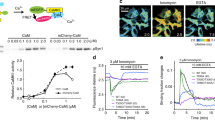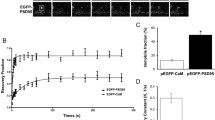Abstract
Activation of calcium/calmodulin-dependent protein kinase II (CaMKII) by calmodulin following calcium entry into the cell is important for long-term potentiation (LTP). Here a model of calmodulin binding and trapping by CaMKII in a dendritic spine was used to estimate levels and durations of CaMKII activation following LTP-inducing tetani. The calcium signal was calcium influx through NMDA receptor channels computed in a highly detailed dentate granule cell model. Calcium could bind to calmodulin and calmodulin to CaMKII. CaMKII subunits were either free, bound with calmodulin, trapped, autonomous, or capped. Strong low-frequency tetanic input produced little calmodulin trapping or CaMKII activation. Strong high-frequency tetanic input caused large numbers of CaMKII subunits to become trapped, and CaMKII was strongly activated. Calmodulin trapping and CaMKII activation were highly dependent on tetanus frequency (particularly between 10 and 100 Hz) and were highly sensitive to relatively small changes in the calcium signal. Repetition of a short high-frequency tetanus was necessary to achieve high levels of CaMKII activation. Three stages of CaMKII activation were found in the model: a short, highly activated stage; an intermediate, moderately active stage; and a long-lasting third stage, whose duration depended on dephosphorylation rates but whose decay rate was faster at low CaMKII activation levels than at high levels. It is not clear which of these three stages is most important for LTP.
Similar content being viewed by others
References
Barnes GN, Slevin JT, Vanaman TC (1995) Rat brain protein phosphatase 2A: An enzyme that may regulate autophosphorylated protein kinases. J. Neurochem. 64:340-353.
Barria A, Muller D, Derkach V, Griffith LC, Soderling TR (1997) Regulatory phosphorylation of AMPA-type glutamate receptors by CaM-KII during long-term potentiation. Science 276:2042-2045.
Bekkers JM, Stevens CF (1989) NMDA and non-NMDA receptors are co-localized at individual excitatory synapses in cultured rat hippocampus. Nature 341:230-233.
Bliss TVP, Collingridge GL (1993) A synaptic model of memory: Long-term potentiation in the hippocampus. Nature 361:31-39.
Blitzer RD, Connor JH, Brown GP, Wong T, Shenolikar S, Iyengar R, Landau EM (1998) Gating of CaMKII by cAMP-regulated protein phosphatase activity during LTP. Science 280:1940-1942.
Brickey DA, Bann JG, Fong Y-L, Perrino L, Brennan RG, Soderling TR (1994) Mutational analysis of the autoinhibitory domain of calmodulin kinase II. J. Biol. Chem. 269:29047-29054.
Burger D, Cox JA, Comte M, Stein EA (1984) Sequential conformational changes in calmodulin upon binding of calcium. Biochemistry 23:1966-1971.
Burger D, Stein EA, Cox JA (1983) Free energy coupling in the interactions between Ca2+, calmodulin and phosphorylase kinase. J. Biol. Chem. 258:14733-14739.
Colbran RJ (1993) Inactivation of Ca2+/calmodulin-dependent protein kinase II by basal autophosphorylation. J. Biol. Chem. 268:7163-7170.
Coomber C (1998) Current theories of neuronal information processing performed by Ca2+/calmodulin-dependent protein kinase II with support and insights from computer modelling and simulation. Computers and Chemistry 22:251-263.
Coussens CM, Teyler TJ (1996) Protein kinase and phosphatase activity regulate the form of synaptic plasticity expressed. Synapse 24:97-103.
Cox JH, Comte M, Mamar-Bachi A, Milos M, Schaer J-J (1988) Cation binding to calmodulin and relation to function. In: Gerday C, Gilles R, Bolis L, eds. Calcium and Calcium Binding Proteins. Springer-Verlag, Berlin. pp. 141-162.
Crouch TH, Klee CB (1980) Positive cooperative binding of calcium to bovine brain calmodulin. Biochemistry 19:3692-3698.
Cummings JA, Mulkey RM, Nicoll RA, Malenka RC (1996) Ca2+ signaling requirements for long-term depression in the hippocampus. Neuron 16:825-833.
DeKoninck P, Schulman H (1998) Sensitivity of CaM Kinase II to the frequency of Ca2+ oscillations. Science 279:227-230.
Desmond NL, Levy WB (1985) Granule cell dendritic spine density in the rat hippocampus varies with spine shape and location. Neuroscience Letters 54:219-224.
Dosemeci A, Albers RW (1996) A mechanism for synaptic frequency detection through autophosphorylation of CaM kinase II. Biophys. J. 70:2493-2501.
Dosemeci A, Gollop N, Jaffe H (1994) Identification of a major autophosphorylation site on postsynaptic density-associated Ca2+/calmodulin-dependent protein kinase. J. Biol. Chem. 269:31330-31333.
Frey U, Morris RGM (1997) Synaptic tagging and long-term potentiation. Nature 385:533-536.
Fukunaga K, Muller D, Miyamoto E (1996) CaM kinase II in long-term potentiation. Neurochem. Int. 28:343-358.
Fukunaga K, Stoppini L, Miyamoto E, Muller D (1993) Long-term potentiation is associated with an increased activity of Ca2+/calmodulin-dependent protein kinase II. J. Biol. Chem. 268:7863-7867.
Gregori L, Gillevet PM, Doan P, Chau V (1985) Mechanisms of enzyme regulation by calmodulin and Ca2C. Curr. Top. Cell. Regul. 27:447-454.
Hanse E, Gustafsson B (1992) Long-term potentiation and field EPSPs in the lateral and medial perforant paths in the dentate gyrus in vitro: A comparison. Eur. J. Neurosci. 4:1191-1201.
Hansel C, Artola A, Singer W (1996) Different threshold levels of postsynaptic [Ca2+]i have to be reached to induce LTP and LTD in neocortical pyramidal cells. J. Physiol. (Paris) 90:317-319.
Hanson PI, Meyer T, Stryer L, Schulman H (1994) Dual role of calmodulin in autophosphorylation of multifunctional CaM kinase may underlie decoding of calcium signals. Neuron 12:943-956.
Hanson PI, Schulman H (1992) Inhibitory autophosphorylation of multifunctional Ca2+/calmodulin-dependent protein kinase analyzed by site-directed mutagenesis. J. Biol. Chem. 267:17216-17224.
Hessler NA, Shirke AM, Malinow R (1993) The probability of transmitter release at a mammalian central synapse. Nature 366:569-572.
Holmes WR (1990) Is the function of dendritic spines to concentrate calcium? Brain Res. 519:338-342.
Holmes WR (1995) Modeling the effect of glutamate diffusion and uptake on NMDA and non-NMDA receptor saturation. Biophys. J. 69:1734-1747.
Holmes WR, Levy WB (1990) Insights into associative long-term potentiation from computational models of NMDA receptormediated calcium influx and intracellular calcium concentration changes. J. Neurophysiol. 63:1148-1168.
Holmes WR, Levy WB (1997) Quantifying the role of inhibition in associative long-term potentiation in dentate granule cells with computational models. J. Neurophysiol. 78:103-116.
Kakiuchi S, Yasuda S, Yamazaki R, Teshima Y, Kanda K, Kakiuchi R, Sobue K (1982) Quantitative determinations of calmodulin in the supernatant and particulate fractions of mammalian tissues. J. Biochem. 92:1041-1048.
Kelly PT, McGuinness TL, Greengard P (1984) Evidence that the major postsynaptic density protein is a component of a Ca2+/calmodulin-dependent protein kinase. Proc. Natl. Acad. Sci. USA 81:945-949.
Kennedy MB, Bennett MK, Erondu NE (1983) Biochemical and immunochemical evidence that the “major postsynaptic density protein” is a subunit of a calmodulin-dependent protein kinase. Proc. Natl. Acad. Sci. USA 80:7357-7361.
Klee CB (1988) Interaction of calmodulin with Ca2+ and target proteins. In: Cohen P, Klee CB, eds. Calmodulin. Elsevier, Amsterdam. pp. 35-56.
Kretsinger RH (1981) Mechanisms of selective signalling by calcium. Neurosci. Res. Prog. Bull. 19(3):213-328.
Linse S, Forsen S (1995) Determinants that govern high-affinity calcium binding. Adv. Second Mess. Phos. Res. 30:89-151.
Linse S, Helmersson A, Forsen S (1991) Calcium binding to calmodulin and its globular domains. J. Biol. Chem. 266:8050-8054.
Lisman J (1989) A mechanism for the Hebb and the anti-Hebb processes underlying learning and memory. Proc. Natl. Acad. Sci. USA 86:9574-9578.
Lisman J (1994) The CaM kinase II hypothesis for the storage of synaptic memory. Trends Neurosci. 17:406-412.
Lisman J, Malenka RC, Nicoll RA, Malinow R (1997) Learning mechanisms: The case for CaM-KII. Science 276:2001-2002.
Luby-Phelps K, Hori M, Phelps JM, Won D (1995) Ca2C-regulated dynamic compartmentalization of calmodulin in living smooth muscle cells. J. Biol. Chem. 270:21532-21538.
Malenka RC (1991) The role of postsynaptic calcium in the induction of long-term potentiation. Mol. Neurobiol. 5:289-295.
Malenka RC, Nicoll RA (1993) NMDA-receptor-dependent synaptic plasticity: Multiple forms and mechanisms. Trends Neurosci. 16:521-527.
Matsushita T, Moriyama S, Fukai T (1995) Switching dynamics and the transient memory storage in a model enzyme network involving Ca2+/calmodulin-dependent protein kinase II in synapses. Biol. Cybern. 72:497-509.
Mayer ML, Westbrook GL, Guthrie PB (1984) Voltage-dependent block by Mg2+ of NMDA responses in spinal cord neurones. Nature 309:261-263.
Mayford M, Wang J, Kandel ER, O'Dell TJ (1995) CaMKII regulates the frequency-response function of hippocampal synapses for the production of both LTD and LTP. Cell 81:891-904.
Meyer T, Hanson PI, Stryer L, Schulman H (1992) Calmodulin trapping by calcium-calmodulin-dependent protein kinase. Science 256:1199-1202.
Michelson S, Schulman H (1994) CaM kinase: A model for its activation and dynamics. J. Theor. Biol. 171:281-290.
Miller SG, Kennedy MB (1986) Regulation of brain type II Ca2+/calmodulin-dependent protein kinase by autophosphorylation: A Ca2+-triggered molecular switch. Cell 44:861-870.
Miller SG, Patton BL, Kennedy MB (1988) Sequences of autophosphorylation sites in neuronal type II CaM kinase that control Ca2+-independent activity. Neuron 1:593-604.
Mukherji S, Soderling TR (1994) Regulation of Ca2+/Calmodulindependent protein kinase II by inter-and intrasubunit-catalyzed autophosphorylations. J. Biol. Chem. 269:13744-13747.
Ouyang Y, Kantor D, Harris KM, Schuman EM, Kennedy MB (1997)Visualization of the distribution of autophosphorylated calcium/ calmodulin-dependent protein kinase II after tetanic stimulation in the CA1 area of the hippocampus. J. Neurosci. 17:5416-5427.
Patton BL, Miller SG, Kennedy MD (1990) Activation of type II calcium/ calmodulin-dependent protein kinase by Ca2+/calmodulin is inhibited by autophosphorylation of threonine within the calmodulin-binding domain. J. Biol. Chem. 265:11204-11212.
Rosenmund C, Clements JD, Westbrook GL (1993) Nonuniform probability of glutamate release at a hippocampal synapse. Science 262:754-757.
Sather W, Dieudonne S, MacDonald JF, Ascher P (1992) Activation and desensitization of N-methyl-D-aspartate receptors in nucleated outside-out patches from mouse neurones. J. Physiol. 450:643-672.
Schulman H (1993) The multifunctional Ca2+/calmodulindependent protein kinases. Curr. Opin. Cell. Biol. 5:247-253.
Sharma RK, Mooibroek M, Wang JH (1988) Calmodulin-stimulated cyclic nucleotide phosphodiesterase isozymes. In: Cohen P, Klee CB, eds. Calmodulin. Elsevier, Amsterdam. pp. 265-295.
Silver RA, Traynelis SF, Cull-Candy SG (1992) Rapid-time-course miniature and evoked excitatory currents at cerebellar synapses in situ. Nature 355:163-166.
Soderling TR (1993) Calcium/calmodulin-dependent protein kinase II: Role in learning and memory. Mol. Cell. Biochem. 127-128:93-101.
Staley KJ, Mody I (1991) Integrity of perforant path fibers and the frequency of action potential independent excitatory and inhibitory synaptic events in dentate gyrus granule cells. Synapse 9:219-224.
Stemmer PM, Klee CB (1994) Dual calcium ion regulation of calcineurin by calmodulin and calcineurin B. Biochemistry 33:6859-6866.
Strack S, Barban MA, Wadzinski BE, Colbran RJ (1997a) Differential inactivation of postsynaptic density-associated and soluble Ca2+/calmodulin-dependent protein kinase II by protein phosphatases 1 and 2A. J. Neurochem. 68:2119-2128.
Strack S, Choi S, Lovinger DM, Colbran RJ (1997b) Translocation of autophosphorylated calcium/calmodulin-dependent protein kinase II to the postsynaptic density. J. Biol. Chem. 272:13467-13470.
Stull JT (1988) Myosin light chain kinases and caldesmon: biochemical properties and roles in skeletal and smooth muscle contractions. In: Cohen P, Klee CB, eds. Calmodulin. Elsevier, Amsterdam. pp. 91-122.
Suzuki T, Okumura-Noji K, Tanaka R, Tada T (1994) Rapid translocation of cytosolic Ca2+/calmodulin-dependent protein kinase II into postsynaptic density after decapitation. J. Neurochem. 63:1529-1537.
Walmsley B, Edwards FR, Tracey DJ (1988) Nonuniform release probabilities underlie quantal synaptic transmission at a mammalian excitatory central synapse. J. Neurophysiol. 60:889-908.
White G, Levy WB, Steward O. (1988) Evidence that associative interactions between synapses during the induction of long-term potentiation occur within local dendritic domains. Proc. Natl. Acad. Sci. USA 85:2368-2372.
White G, Levy WB, Steward O (1990) Spatial overlap between populations of synapses determines the extent of their interaction during the induction of long-term potentiation and depression. J. Neurophysiol. 64:1186-1198.
Zador A, Koch C, Brown TH (1990) Biophysical model of a Hebbian synapse. Proc. Natl. Acad. Sci. USA 87:6718-6722.
Author information
Authors and Affiliations
Rights and permissions
About this article
Cite this article
Holmes, W.R. Models of Calmodulin Trapping and CaM Kinase II Activation in a Dendritic Spine. J Comput Neurosci 8, 65–86 (2000). https://doi.org/10.1023/A:1008969032563
Issue Date:
DOI: https://doi.org/10.1023/A:1008969032563




